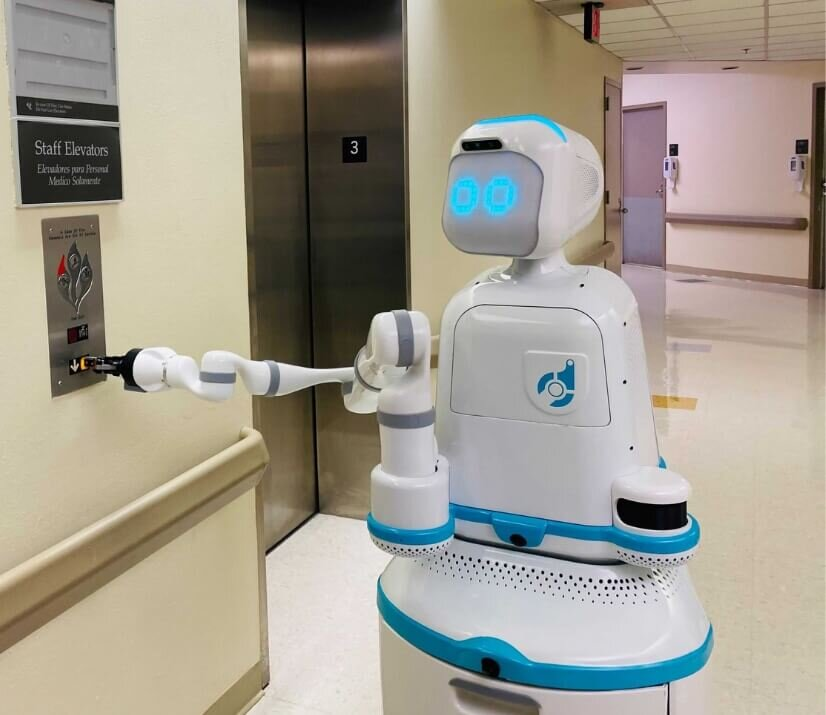PRE2024 3 Group12
Emotional support robot for hospitalized children
Group members
| Name | Student number |
|---|---|
| Mara Ioana Burghelea | 1788795 |
| Malina Corduneanu | 1816071 |
| Alexia Dragomirescu | 1793543 |
| Briana Anamaria Isaila | 1785923 |
| Marko Mrvelj | 1841246 |
| Ana Sirbu | 1829858 |
Introduction
(Name of the robot) - is an emotional support robot made specifically with children that have a long-term hospital stay in mind.
Problem statement
The problem we aim to offer a solution to arises from the difficulties children face with hospital stay. Numerous children with health difficulties are forced to stay in the hospital for prolonged periods of time for different reasons. While an adult may be able to rationalise and accept this experience, many times, children are not able to process it and so it becomes heavy on their mental state. Just as with any patient, children on hospital stay cannot have visitors at all times and are not always offered the emotional help and attention they require. In this regard, hospitals currently offer time slots dedicated to play time and socialisation for children on hospital stay, however this is not a solution for the isolation and anxiety these children face on a daily basis. What about the children who are not able to leave their room or are simply not allowed in the vicinity of other children due to their illness?
Solution
With this in mind, we propose a robot companion, whose functionality is dedicated to interacting with children. We aim to provide each child in need with an all time companion capable of having conversations and offer support at any moment. In this way, at times of difficulty such as during treatment, the child can listen to their cheerful companion being there for them when no other human can. It’s been proven in many instances that children, and humans in general, are able to form meaningful connections with non-human entities such as animals, toys and also robots. In this regard, we believe that and intercative and expressive companion would help lift a bit of the anxiety surrounding the hospital.
Users - description (Targeted stakeholders)
Hospitals and caregiving facilities could purchase this technology to improve the well-being of hospitalised children or children who need to be supervised or contained for longer periods due to illnesses. This technology would be helpful to such institutions because it would boost the disposition of sick children, which, as shown in multiple studies, increases the strength of the body and helps fight against the sickness. Moreover, parents could feel more relieved knowing that their children feel less alone while they are not in the hospital with them.
The main users, the intended target of this technology, would be sick, young patients. Illness itself is a very stressful thing both on the mind and on the body. For children, this becomes even more stressful since they do not fully understand what is happening to them. Feelings of loneliness and lack of interaction with loved ones and other children can have lasting effects on the development of the child and their mental well-being. Therefore, a robot that can keep them company during stressful moments and distract them by playing with them, talking to them, and telling them bedtime stories would make the treatment plan for the child more bearable and less frightening.
State of the art
Children who spend a lot of time in hospital and medical facilities are prone to experience stress, anxiety and emotional distress. Emotional support robots are emerging as a potential solution to provide companionship and comfort. In this section, we are going to talk about the state of the art in emotional support robots for children.
Several robots have been developed already with the scope of providing emotional support, but it is important to note that most of the robots developed were not designed specifically for children in hospitals. Some mentionable examples are:
PARO: A robotic seal designed to provide comfort through tactile interactions and soothing behaviours for elderly patients with Alzheimer. This approach is similar to animal therapy, for example, but with robots. While it has been proven to reduce stress, it is not specifically targeted for children and it does not engage in interactive play or personalised companionship tailored for young users.

Pepper: is a semi-humanoid robots with the ability to read emotions. It is used as a receptionist at several offices in the UK and is able to identify visitors with the use of facial recognition, send alerts for meeting organisers and arrange for drinks to be made. While it has conversational capabilities and can recognise emotions, its primary function is not emotional support for children, and it lacks deep personalisation and game-playing features as well as the caring aspect of emotional support needed for hospitalised children.
Huggable: is a robotic companion capable of active relational and touch-based interactions with a person, targeted for children in hospitals. However, it’s capabilities are still limited, and while it provides emotional support, its interactive play, personalisation and tailoring to users is not as advanced as envisioned in an ideal emotional support robot.

Moxi: is a robotic assistant meant to help nurses and hospital staff with administrating medication and helping with repetitive tasks. While it enhances efficiency in hospital environments, Moxi does not engage in direct patient interactions for emotional support or entertainment, making it unsuitable for pediatric emotional care. Despite the advancements in the world of robotics and emotional support robots, some challenges still stand. Developing robots with the particular needs of children in hospitals and that can adapt to the personal needs of every child remains a key challenge. Another important aspect is maintaining the attention for longer periods of time which is a key aspect in the emotional support of kids who must spend a lot of time in the hospitals, this challenge implies constant updates in interaction style and content. To maximize effectiveness, emotional support robots should be seamlessly integrated into hospital care routines, working alongside medical staff and therapists. Lastly, ensuring data security and ethical use of AI in sensitive environments like hospitals is crucial. Regulations must be in place to protect children's privacy, particularly regarding data collection and emotional analysis.

In conclusion, these robots will become even more effective in providing meaningful emotional support. However, current solutions either lack the specific focus on children or do not incorporate essential features like interactive play and deep personalisation. Future research and development should address these gaps to create more suitable and effective emotional support robots for pediatric patients.
https://provenrobotics.ai/pepper-the-emotional-robot/
https://www.paroseal.co.uk/
https://bmcgeriatr.biomedcentral.com/articles/10.1186/s12877-019-1244-6
https://www.media.mit.edu/projects/huggable-a-social-robot-for-pediatric-care/overview/
https://www.diligentrobots.com/moxi
Literature research
Research: General use of Socially Assistive Robots in hospitals During the COVID-19 pandemic, there was an increased emphasis on minimizing human contact to avoid spreading the disease. This also allowed for significant developments in the field of robotics that are used in healthcare. We can divide robots in healthcare into 5 main groups:
- Interventional Robots - employed in performing precise surgical procedures
- Teleoperated Robots - enable healthcare professionals to perform tasks remotely
- Socially Assistive Robots (SARs) - focus on providing cognitive and emotional support through social interaction
- Assistive Robots - focus on providing physical support for individuals with impairments and disabilities
- Service Robots - handling logistical tasks within healthcare facilities.
We focus on the third group - Socially Assistive Robots.
SARs are designed to engage with individuals, offering companionship and assistance without physical contact. In Belgium, a study introduced a robot named James to older adults with mild cognitive impairment during the first lockdown. Participants reported that James helped alleviate feelings of loneliness and encouraged meaningful activities, highlighting the potential of SARs to support mental health during such challenging times [1].
In long-term care facilities, SARs have been employed to perform routine health screenings, reducing direct contact between staff and residents. A study conducted in a Canadian long-term care center utilized a robot to autonomously screen staff members for COVID-19 symptoms. The findings indicated that staff had a positive attitude towards the robot, suggesting that SARs can effectively assist in health monitoring tasks while minimizing infection risks [2].
Beyond health monitoring, SARs have been instrumental in providing social interaction and reducing feelings of isolation. Research has shown that the presence of SARs can lead to improved mental health outcomes and a reduction in feelings of loneliness among older adults [3][5].
The pandemic has also influenced public perception of SARs. As traditional social interactions became limited, individuals began to recognize the potential benefits of SARs in providing companionship and support. Surveys conducted during the pandemic reveal a positive shift in attitudes toward SARs, with many viewing them as viable companions to mitigate social isolation [4].
In mental healthcare, SARs serve roles such as companions, coaches, and therapeutic play partners. They assist in monitoring treatment participation, offering encouragement, and leading users through clinically relevant activities. Research indicates that SARs can be effective tools in mental health interventions, providing support and enhancing patient engagement. [6]
In summary, there is a great demand and use for Socially Assistive Robots in healthcare settings. Their ability to provide emotional support, facilitate social interactions, and perform essential monitoring tasks position them as vital tools in patient care and addressing the challenges of social isolation [1][2][3][4][5][6].
References:
- Van Assche, M., Moreels, T., Petrovic, M., Cambier, D., Calders, P., & Van de Velde, D. (2023). The role of a socially assistive robot in enabling older adults with mild cognitive impairment to cope with the measures of the COVID-19 lockdown: A qualitative study. Scandinavian Journal of Occupational Therapy, 30(1), 42-52.
- Getson, C., & Nejat, G. (2022). The adoption of socially assistive robots for long-term care: During COVID-19 and in a post-pandemic society. Healthcare Management Forum, 35(5), 301-309.
- Getson, C., & Nejat, G. (2021). Socially Assistive Robots Helping Older Adults through the Pandemic and Life after COVID-19. Robotics, 10(3), 106.
- Ghafurian, M., Ellard, C., & Dautenhahn, K. (2020). Social Companion Robots to Reduce Isolation: A Perception Change Due to COVID-19. arXiv preprint, arXiv:2008.05382.
- "Application of Social Robots in Healthcare: Review on the Field, Aware Home Environments" - Sensors, 2023.
- "Integrating Socially Assistive Robotics into Mental Healthcare Interventions: Applications and Recommendations for Expanded Use" - Clinical Psychology Review, 2015.
Functionality of the robot
We aim to create a prototype which can alleviate the emotional pain of children in hospitals.
How do we plan to do this? What functionalities should the robot have?
Progress - Workload
Week 1
| Name | Task | No. of hours |
|---|---|---|
| Mara Ioana Burghelea | Users | |
| Malina Corduneanu | Research - psychology (AI/ robots and kids) | |
| Alexia Dragomirescu | State of the art | |
| Briana Anamaria Isaila | Functionality of the robot | |
| Marko Mrvelj | Research - robots in healthcare | |
| Ana Sirbu | Problem statement |